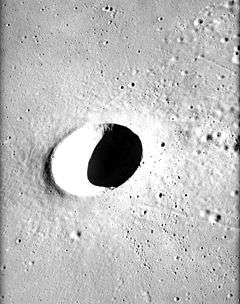Euclides (crater)
|
Lunar Orbiter 4 image | |
| Coordinates | 7°24′S 29°30′W / 7.4°S 29.5°WCoordinates: 7°24′S 29°30′W / 7.4°S 29.5°W |
|---|---|
| Diameter | 12 km |
| Depth | 1.3 km |
| Colongitude | 29° at sunrise |
| Eponym | Euclid |

Euclides is a small lunar impact crater located near the eastern edge of Oceanus Procellarum, about 30 kilometers to the west of the Montes Riphaeus mountains. The mare in the vicinity is devoid of significant craters, but to the west is an area of low rises. The crater is named after the Greek mathematician Euclid.
Euclides is a bowl-shaped formation with a circular rim. It is surrounded by streaks of ejecta that have a higher albedo than the nearby maria. This nebulous skirt of light-hued material makes this feature very prominent under a high Sun, and it is one of the brightest sites on the Moon.
Euclides D

Euclides D is a small lunar impact crater in the Mare Cognitum. It has a diameter of 6 kilometers and a depth of 1.3 kilometers. It lies to the southeast of Euclides, beyond the Montes Riphaeus mountains.
In 1976, Euclides D was renamed Eppinger by the IAU to honor Hans Eppinger, a professor of pathological anatomy at Graz. However, in 2002, after Eppinger's association with Nazi prison camps had been brought to the attention of the IAU's Working Group for Planetary System Nomenclature, the name was changed.[1]
Satellite craters
By convention these features are identified on lunar maps by placing the letter on the side of the crater midpoint that is closest to Euclides.
| Euclides | Latitude | Longitude | Diameter |
|---|---|---|---|
| C | 13.2° S | 30.0° W | 10 km |
| D | 9.4° S | 25.7° W | 6 km |
| E | 6.3° S | 25.1° W | 4 km |
| F | 6.3° S | 33.7° W | 5 km |
| J | 6.4° S | 28.5° W | 4 km |
| K | 4.2° S | 24.7° W | 6 km |
| M | 10.4° S | 28.2° W | 6 km |
| P | 4.5° S | 27.6° W | 66 km |
The following craters have been renamed by the IAU.
- Euclides B — See Norman.
References
- ↑ "IAU Removes Designation Of Lunar Crater Named For Suspected Nazi War Criminal". Luna Society International. 9 August 2002. Retrieved 11 August 2016.
- Enersen, Ole Daniel (2007). "Hans Eppinger". Who Named It?. Retrieved 2007-08-07.
- Andersson, L. E.; Whitaker, E. A. (1982). NASA Catalogue of Lunar Nomenclature. NASA RP-1097.
- Blue, Jennifer (July 25, 2007). "Gazetteer of Planetary Nomenclature". USGS. Retrieved 2007-08-05.
- Bussey, B.; Spudis, P. (2004). The Clementine Atlas of the Moon. New York: Cambridge University Press. ISBN 978-0-521-81528-4.
- Cocks, Elijah E.; Cocks, Josiah C. (1995). Who's Who on the Moon: A Biographical Dictionary of Lunar Nomenclature. Tudor Publishers. ISBN 978-0-936389-27-1.
- McDowell, Jonathan (July 15, 2007). "Lunar Nomenclature". Jonathan's Space Report. Retrieved 2007-10-24.
- Menzel, D. H.; Minnaert, M.; Levin, B.; Dollfus, A.; Bell, B. (1971). "Report on Lunar Nomenclature by the Working Group of Commission 17 of the IAU". Space Science Reviews. 12 (2): 136–186. Bibcode:1971SSRv...12..136M. doi:10.1007/BF00171763.
- Moore, Patrick (2001). On the Moon. Sterling Publishing Co. ISBN 978-0-304-35469-6.
- Price, Fred W. (1988). The Moon Observer's Handbook. Cambridge University Press. ISBN 978-0-521-33500-3.
- Rükl, Antonín (1990). Atlas of the Moon. Kalmbach Books. ISBN 978-0-913135-17-4.
- Webb, Rev. T. W. (1962). Celestial Objects for Common Telescopes (6th revised ed.). Dover. ISBN 978-0-486-20917-3.
- Whitaker, Ewen A. (1999). Mapping and Naming the Moon. Cambridge University Press. ISBN 978-0-521-62248-6.
- Wlasuk, Peter T. (2000). Observing the Moon. Springer. ISBN 978-1-85233-193-1.
